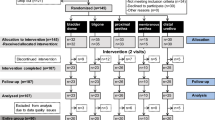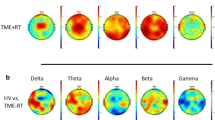Abstract
To assess abnomalities of sensory conduction in anorectal disease we have evaluated peripheral sensory perception and somatosensory evoked potentials produced by rectal stimulation in control subjects and patients with either constipation or idiopathic faecal incontinence. Evoked potentials were also recorded after posterior tibial and dorsal genital nerve stimulation. Rectal sensation was also assessed using electrical stimulation. Reproducible evoked potential recordings after anorectal stimulation were possible in only a minority of subjects and when recorded showed intersubject and intrasubject variation. In the constipated group there was a significant difference in rectal electrical sensation (P<0.05) from controls. We conclude that peripheral sensory testing demonstrates an abnormality in severe constipation. However, cerebral evoked potentials cannot be reliably recorded after rectal stimulation, and when recorded the latencies are of too broad a range to discriminate between health and disease. This probably relates to the difference between somatic and visceral pathways.
Résumé
Pour étudier les anomalies de la conduction sensitive dans les maladies ano-rectales nous avons évalué la perception sensitive périphérique et les potentiels évoqués somesthésiques produits par la stimulation rectale chez des contrôles et des patients avec soit une constipation, soit une incontinence fécale idiopathique. Les potentiels évoqués étaient aussi enregistrés après stimulation du nerf tibial postérieur ou du nerf dorsal génital. La sensation rectale était aussi étudié par stimulation électrique. L'enregistrement reproductible des potentiels évoqués après stimulation ano-rectale était possible chez seulement une minorité de sujets et en cas d'enregistrement montrait des variations entre les sujets et chez un même sujet. Dans le groupe des malades constipés il y avait une différence significative de la sensation rectale électrique (P<0.05) avec les contrôles. Nous concluons que les tests sensitifs périphériques montrent une anomalie chez les malades ayant une constipation sévère. Cependant les potentiels évoqués cérébraux ne peuvent être valablement enregistrés après stimulation rectale et lorsqu'ils sont enregistrés les latences ont un taux de variation trop large pour être discriminatif entre les sujets sains et malades. Ceci est probablement en relation avec la différence entre les voies de conduction somatiques et viscérales.
Similar content being viewed by others
References
Goligher JC, Hughes ESR (1951) Sensibility of the Rectum and Colon: its role in the mechanism of anal continence. Lancet 1:543–548
Henry MM, Snooks SJ, Barnes PRH, Swash M (1985) Investigations of disorders of the anorectum and colon. Ann Roy Coll Surg 67:355–360
Roe AM, Bartolo DCC, Cervero F, Mortensen NJMcC (1986) New method for assessment of anal sensation in various anorectal disorders. Br J Surg 73:310–321
Rogers J, Henry MM, Misiewicz JJ (1988) Combined sensory and motor deficit in primary neuropathic faecal incontinence. Gut 29:5–9
Kamm MA, Lennard-Jones JE (1990) Rectal mucosal electrosensory testing—evidence for a rectal sensory neuropathy in idiopathic constipation. Dis Colon Rectum 33:419–423
Dawson GD (1947) Cerebral responses to electrical stimulation of peripheral nerve in man. J Neurol Neurosurg Psychiatry 10:134–140
Giblin D (1964) Somatosensory evoked potentials in healthy subjects and in patients with lesions of the nervous system. Ann NY Acad Sci 112:93–142
Matthews WB, Small DG (1979) Serial recording of visual and somatosensory evoked potentials in multiple sclerosis. J Neurol Sci 40:11–21
Negamy EE, Sedgwick EM (1979) Delayed cervical somatosensory potentials in cervical spondylosis. J Neurol Neurosurg Psychiatry 42:238–241
Jones SJ, Wynn Parry CB, Landi A (1981) Diagnosis of brachial plexus traction lesions by sensory nerve action potentials and somatosensory evoked potentials. Injury 12:376–382
Glick ME, Meshkinpour H, Haldeman S, Bhatia NN, Bradley WE (1982) Colonic Dysfunction in Multiple Sclerosis. Gastroenterology 83:1002–1007
Glick ME, Meshkinpour H, Haldeman S, Hoehler E, Downey N, Bradley WE (1984) Colonic Dysfunction in Patients with thoracic spinal cord injury. Gastroenterology 86:287–294
Freeman NV, Burge DM, Soar JS, Sedwick EM (1980) Anal evoked potentials. Z Kinderchir 31:22–30
Kaplan PE (1981) A somatosensory evoked response obtained after stimulation of the contralateral pudendal nerve. A preliminary report. Electroencephalorg Clin Neurophysiol 21:585–587
Opsomer RJ, Guerit JM, Wese FX, Van Cangh PJ (1986) Pudendal cortical somatosensory evoked potentials. J Urol 135:1216–1218
Badr G, Carlsson CA, Fall M, Friberg S, Lindstrom L, Ohlsson B (1982) Cortical evoked potentials following stimulation of the urinary bladder in man. Electroencephalogr Clin Neurophysiol 54:494–498
Gerstenberg T, Hald T, Meyhoff HH (1981) Urinary cerebralevoked potentials mediated through urethral sensory nerves—a preliminary report. Prog Clin Biol Res 78:141–143
Meunier P, Collet L, Duclaux R, Chery-Croze S (1987) Endorectal cerebral evoked potentials in human. Int J Neurosci 37:793–796
Frieling T, Enck P, Wienbeck M (1989) Cerebral responses evoked by electrical stimulation of rectosigmoid in normal human subjects. Dig Dis Sci 34:202–205
Collet L, Meunier P, Duclaux R, Chery-Croze S, Falipou P (1988) Cerebral evoked potentials after endorectal mechanical stimulation in humans. Am J Physiol 254:G477-G482
Parks AG (1975) Anorectal Incontinence. Proc Royal Soc Med 68:681–690
Speakman CTM, Kamm MA (1993) Abnormality of visceral autonomic nerves in neurogenic faecal incontinence. Gut 34:215–221
Baldi F, Ferrarini F, Corinaldesi R, Balestra R, Cassan M, Fenati GP, Barbara L (1982) Function of the internal anal sphincter and rectal sensitivity in idiopathic constipation. Digestion 24:14–22
Schiller LR, Santa CA, Schmulen C, Hendler RS, Harford WV, Fordtran JS (1982) Pathogenesis of fecal incontinence in diabetes mellitus. N Engl J Med 307:1666–1671
Kiff ES, Swash M (1984) Slowed conduction in the pudendal nerves in idiopathic (neurogenic) faecal incontinence. Br J Surg 71:614–616
Neill ME, Swash M (1980) Increased motor unit fibre density in the external anal sphincter muscle in anorectal incontinence: a single fibre EMG study. J Neurol Neurosurg Psychiatry 43:343–347
Lastimosa ACB, Bass NH, Stanback K, Norvell EE (1982) Lumbar spinal cord early cortical evoked potentials after tibial nerve stimulation: effects of stature on normative data. Electroencephalogr Clin Neurophysiol 54:499–507
Loening-Baucke V, Read NW, Yamada T (1991) Cortical evoked potentials recorded after rectal stimulation. Electroencephalogr Clin Neurophysiol 80:490–495
Duthie HL, Gairns FW (1960) Sensory nerve-endings and sensation in the anal region of man. Br J Surg 47:585–594
Nagasaki A, Ikeda K, Sumitomo K (1989) Rectoanal reflex induced by H2 thermal stimulation. Dis Colon Rectum 32:765–768
Parks AG, Porter NH, Melzak J (1962) Experimental study of the reflex mechanism controlling the muscles of the pelvic floor. Dis Colon Rectum 5:407–414
Scharli AF, Kiesewetter WB (1970) Defecation and continence: some new concepts. Dis Colon Rectum 13:81–107
Last RJ (1984) Anatomy—regional and applied. Seventh edition. Churchill Livingstone, Edinburgh, pp 328–329
Gunterberg B, Kewenter J, Petersen I, Stener B (1976) Anorectal function after major resections of the sacrum with bilateral or unilateral sacrifice of sacral nerves. Br J Surg 63:546–554
Cervero G, Tattersall JEH (1986) Somatic and visceral intergration in the thoracic spinal cord. In. Progress in Brain Research Eds Cervero F, Morrison JFB, 67:189–205
Procacci P (1969) A survey of modern concepts of pain. In Vinken PJ, Bruyn GW (Eds) Handbook of Clinical Neurology, Vol I, North-Holland Publishing Company. Amsterdam, pp 114–146
Cervero F, Connell LA, Lawson SN (1984) Somatic and visceral primary afferents in the lower thoracic dorsal root ganglia of the cat. J Comp Neurol 228:422–431
Cervero F (1988) Neurophysiology of gastrointestinal pain. In: Grundy D, Read NW (Eds) Balliere's Clinical Gastroenterology. Ballière Tindall, London, pp 183–199
Nathan PW (1963) Results of antero-lateral cordotomy. J Neurology, Neurosurg Psychiatry 26:353–362
Tyner CF (1979) Splanchnic nerve activation of single cells in the cat's postcruciate motorsensory cortex. Exp Neurol 63:76–93
Lewis T (1942) Pain Macmillan, London
Chiappa KH (1983) Evoked Potentials in Clinical Medicine. New York, Raven Press
Author information
Authors and Affiliations
Additional information
C. T. M. Speakman is supported by the Sir Alan Parks Research Foundation, The Royal College of Surgeons, M. A. Kamm by the St. Mark's Research Foundation
Rights and permissions
About this article
Cite this article
Speakman, C.T.M., Kamm, M.A. & Swash, M. Rectal sensory evoked potentials: an Assessment of their clinical value. Int J Colorect Dis 8, 23–28 (1993). https://doi.org/10.1007/BF00341272
Accepted:
Issue Date:
DOI: https://doi.org/10.1007/BF00341272




